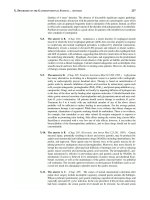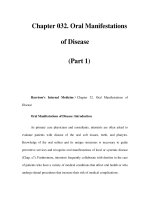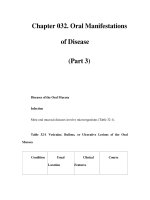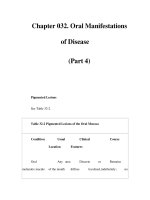Chapter 054. Skin Manifestations of Internal Disease (Part 11) pptx
Bạn đang xem bản rút gọn của tài liệu. Xem và tải ngay bản đầy đủ của tài liệu tại đây (81.17 KB, 5 trang )
Chapter 054. Skin Manifestations
of Internal Disease
(Part 11)
a
Also lentigines.
b
Polyostotic fibrous dysplasia.
c
See also "Papulonodular Skin Lesions."
d
Late 1980s.
A proliferation of melanocytes results in the following pigmented lesions:
lentigo, melanocytic nevus, and melanoma (Chap. 83). In an adult, the majority of
lentigines are related to sun exposure, which explains their distribution.
, in the Peutz-Jeghers and LEOPARD [lentigines; ECG abnormalities,
primarily conduction defects; ocular hypertelorism; pulmonary stenosis and
subaortic valvular stenosis; abnormal genitalia (cryptorchidism, hypospadias);
retardation of growth; and deafness (sensorineural)] syndromes, lentigines do
serve as a clue to systemic disease. In LEOPARD syndrome, hundreds of
lentigines develop during childhood and are scattered over the entire surface of the
body.
The lentigines in patients with Peutz-Jeghers syndrome are located
primarily around the nose and mouth, on the hands and feet, and within the oral
cavity. While the pigmented macules on the face may fade with age, the oral
lesions persist. However, similar intraoral lesions are also seen in Addison's
disease and as a normal finding in darkly pigmented individuals.
Patients with this autosomal dominant syndrome (due to mutations in a
novel serine threonine kinase gene) have multiple benign polyps of the
gastrointestinal tract, testicular tumors, and an increased risk of developing
gastrointestinal (primarily colon), pancreatic, and gynecologic cancers.
In the Carney complex, numerous lentigines are also seen, but in
association with cardiac myxomas. This autosomal dominant disorder is also
known as the LAMB (lentigines, atrial myxomas, mucocutaneous myxomas, and
blue nevi) syndrome or NAME [nevi, atrial myxoma, myxoid neurofibroma, and
ephelides (freckles)] syndrome. These patients can also have evidence of
endocrine overactivity in the form of Cushing's syndrome, acromegaly, or sexual
precocity.
The third type of localized hyperpigmentation is due to a local increase in
pigment production, and it includes ephelides and café au lait macules (CALM).
The latter are most commonly associated with two disorders—neurofibromatosis
(NF) and McCune-Albright syndrome. CALM are flat, uniformly brown in color
(usually two shades darker than uninvolved skin), and can vary in size from 0.5–
12 cm.
Approximately 80–90% of adult patients with type I NF will have six or
more CALM measuring ≥ 1.5 cm in diameter. Additional findings are discussed in
the section on neurofibromas (see "Papulonodular Skin Lesions," below).
In comparison with NF, the CALM in patients with McCune-Albright
syndrome [polyostotic fibrous dysplasia with precocious puberty in females due to
mosaicism for an activating mutation in a G protein (G
s
α) gene] are usually
larger, more irregular in outline, and tend to respect the midline.
CALM have also been associated with pulmonary stenosis (Watson
syndrome), tuberous sclerosis, the LEOPARD syndrome, and multiple endocrine
neoplasia (MEN), but a few such lesions can be found in normal individuals.
In incontinentia pigmenti, dyskeratosis congenita, and bleomycin
pigmentation, the areas of localized hyperpigmentation form a pattern—swirled in
the first, reticulated in the second, and flagellate in the third. In dyskeratosis
congenita, atrophic reticulated hyperpigmentation is seen on the neck, trunk, and
thighs and is accompanied by nail dystrophy, pancytopenia, and leukoplakia of the
oral and anal mucosae.
The latter often develops into squamous cell carcinoma. In addition to the
flagellate pigmentation (linear streaks) on the trunk, patients receiving bleomycin
often have hyperpigmentation overlying the elbows, knees, and small joints of the
hand.
Localized hyperpigmentation is seen as a side effect of several other
systemic medications, including those that produce fixed drug reactions
[nonsteroidal anti-inflammatory drugs (NSAIDs), sulfonamides, barbiturates, and
tetracyclines] and those that can complex with melanin (antimalarials) or iron
(minocycline). Fixed drug eruptions recur in the exact same location as circular
areas of erythema that can become bullous and then resolve as brown macules.
The eruption usually appears within hours of administration of the offending
agent, and common locations include the genitalia, extremities, and perioral
region. Chloroquine and hydroxychloroquine produce gray-brown to blue-black
discoloration of the shins, hard palate, and face, while blue macules (often
misdiagnosed as bruises) can be seen on the lower extremities and in sites of
inflammation with prolonged minocycline administration. Estrogen in oral
contraceptives can induce melasma—symmetric brown patches on the face,
especially the cheeks, upper lip, and forehead. Similar changes are seen in
pregnancy and in patients receiving phenytoin.









